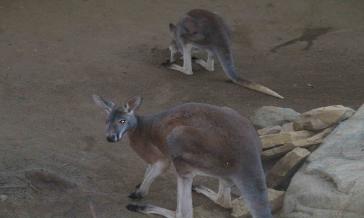| Biology: |
| Implicating Continental Drift in Speciation: The displacement and rearrangement of land masses over geologic time has helped to create biological diversity on our planet. Without the profound effects created by geological reconfiguration life on earth might have been very different from the way that it is now. Continental drift is the movement of land masses due to the effects of plate tectonics. Originally all of the world’s surface land was located in one region on the globe, Pangea. This supercontinent supposedly began to separate late in the Triassic Period (245 to 208 million years ago) into a southern landmass, Gondwanaland, and the northern landmass Laurasia. Gondwanaland was composed of the modern day continents of India, Africa, Australia, Antarctica and South America. These continents began to break up and head towards their present day locations only some 130 million years ago. Because these two land masses were the only two continents on the face of the earth for about 520 million years they are perhaps two of the most important geological structures of the last billion years. Our modern understanding of continental drift, and the structures that it has produced, has inexorably impacted our understanding of the fossil record and has given us detailed information about the evolutionary history of animal species. The earth is populated by tens, perhaps hundreds of millions of animal species. We can attribute this fantastic diversity, in part, to an evolutionary trend called speciation. Speciation is a phenomenon that normally takes place when a group of animals of the same species find themselves isolated from one another. They can be isolated geographically by great distances, rising mountains or large bodies of water. They can also be isolated by biological or behavioral barriers. One species is distinguished from another by their inability to create viable offspring together, and this is the precise effect that isolation can have on an animal species. Once a group of animals of the same species becomes split apart or isolated, they begin to be changed, molded and fashioned by the hand of natural selection to more properly fit in with their surroundings. After a period of time these two groups begin to be so different anatomically and genetically that soon it becomes impossible for them to procreate. This inability for two animals, that were once the same species, to create viable offspring is called speciation. Before 130 million B.C. the land mass of Gondwanaland was the home to many types of mammals. Thanks to plate tectonics it was split in two to create modern day South America and Australia. Many mammals called Gondwanaland their home and after it split, two very different types of mammals emerged. One order of mammal began to both thrive in Australia and die out in South America. These were marsupials, or pouched mammals, and they evolved into modern day kangaroos, koalas, wallabies, wombats and tasmanian devils. Infant mammals that leave the mother’s stomach and finish off their gestation period in a warm, nutrient providing pouch are marsupials. The only type of marsupial species able to survive in the South American continent after the break up of Gondwanaland was the opossum. On the other hand, on the isolated continent of Australia, almost all of the indigenous mammals are in fact marsupials. Very soon placential mammals, (the order that we belong to) and marsupials were on opposite sides of the globe. Today marsupials cannot mate with placential mammals. Their genetic and anatomical differences created unsurmountable barriers, making them sexually incompatible. The story of the order marsupialia is perhaps one of the most dramatic demonstrations of the effects of continental drift on speciation. The different types of primates with whom humans were able to mate have long since died out. At one time we were very similar anatomically and genetically to some of the other species of primates on the planet. Humans and Neanderthals were sexually compatible, meaning that functionally we were not two different species. Because of behavioral differences, probably due to discrepancies in socialization and intellect we simply did not mate with their kind very much at all. Animal speciation can be caused by geographical barriers, sexual barriers, behavioral barriers -and this example makes it obvious that social barriers can prove causal as well. If some of these barriers had not existed, and if our geographical configurations were not in constant flux then humans may never have evolved the way that they did, or may never have evolved at all. Evolution: noun Change in the genetic composition of a population during successive generations. The development of species resulting from the way natural selection acts on the genetic variation among individuals. Gondwanaland: noun The hypothetical protocontinent of the Southern Hemisphere that, according to the theory of plate tectonics, broke up into India, Australia, Antarctica, Africa, and South America. Neanderthal: noun An extinct human species (Homo neanderthalensis) or subspecies (Homo sapiens neanderthalensis) living during the late Pleistocene Epoch throughout most of Europe and parts of Asia and northern Africa and associated with Middle Paleolithic tools. Order: noun Biology. A taxonomic category of organisms ranking above a family and below a class. Pangea: noun A hypothetical supercontinent that included all the landmasses of the earth. Before the Triassic Period Pangaea broke up into Laurasia and Gondwanaland. Speciation: noun The evolutionary formation of new biological species, usually by the division of a single species into two or more genetically distinct ones. Triassic Period: noun The period from 190 million to 230 million years ago. Marked by dinosaurs, marine reptiles; volcanic activity |

| Organization for the Advancement of Interdisciplinary Learning |